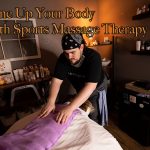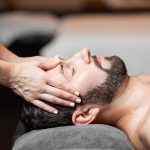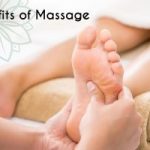As you lie on the table under crisp, fresh sheets, hushed music draws you into the moment. The smell of sage fills the air and you hear the gentle sound of massage oil being warmed in your therapist’s hands. The pains of age, the throbbing from your overstressed muscles, the sheer need to be touched — all cry out for therapeutic hands to start their work. Once the session gets underway, the problems of the world fade into an oblivious 60 minutes of relief and all you can comprehend right now is not wanting it to end.
But what if that hour of massage did more for you than just take the pressures of the day away? What if that gentle, Swedish massage helped you combat cancer? What if bodywork helped you recover from a strained hamstring in half the time? What if your sleep, digestion and mood all improved with massage and bodywork? What if these weren’t just “what ifs”?
Evidence is showing that the more massage you can allow yourself, the better you’ll feel. Here’s why.
Massage as a healing tool has been around for thousands of years in many cultures. Touching is a natural human reaction to pain and stress, and for conveying compassion and support. Think of the last time you bumped your head or had a sore calf. What did you do? Rubbed it, right? The same was true of our earliest ancestors. Healers throughout time and throughout the world have instinctually and independently developed a wide range of therapeutic techniques using touch. Many are still in use today, and with good reason. We now have scientific proof of the benefits of massage – benefits ranging from treating chronic diseases and injuries to alleviating the growing tensions of our modern lifestyles. Having a massage does more than just relax your body and mind – there are specific physiological and psychological changes which occur, even more so when massage is utilized as a preventative, frequent therapy and not simply mere luxury. Massage not only feels good, but it can cure what ails you.
The Consequences of Stress
Experts estimate that 80 percent to 90 percent of disease is stress-related. Massage and bodywork is there to combat that frightening number by helping us remember what it means to relax. The physical changes massage brings to your body can have a positive effect in many areas of your life. Besides increasing relaxation and decreasing anxiety, massage lowers your blood pressure, increases circulation, improves recovery from injury, helps you to sleep better and can increase your concentration. It reduces fatigue and gives you more energy to handle stressful situations.
Massage is a perfect elixir for good health, but it can also provide an integration of body and mind. By producing a meditative state or heightened awareness of living in the present moment, massage can provide emotional and spiritual balance, bringing with it true relaxation and peace.
The incredible benefits of massage are doubly powerful if taken in regular “doses.” Dr. Maria Hernandez-Reif, from the Touch Research Institute (TRI) at the University of Miami, is known for her massage research, along with colleague Tiffany Field. Together, they and other researchers have done outstanding work proving the value of massage. While their studies have shown we can benefit from massage even in small doses (15 minutes of chair massage or a half-hour table session), Hernandez-Reif says they know from their research that receiving bodywork 2-3 times a week is highly beneficial. And if we lived in a fantasy world, Hernandez-Reif has the answer. “I feel a daily massage is optimal.”
It’s undoubtedly a wonderful thing when your therapist begins unwinding those stress-tightened muscles, and your day’s troubles begin to fade away. But it’s the cherry on top to know this “medicine” only gets better with frequency.
What You Already Know: The Benefits of Massage
In an age of technical and, at times, impersonal medicine, massage offers a drug-free, non-invasive and humanistic approach based on the body’s natural ability to heal itself. So what exactly are the benefits to receiving regular massage and/or bodywork treatments?
– Increases circulation, allowing the body to pump more oxygen and nutrients into tissues and vital organs.
– Stimulates the flow of lymph, the body’s natural defense system, against toxic invaders. For example, in breast cancer patients, massage has been shown to increase the cells that fight cancer.
– Increased circulation of blood and lymph systems improves the condition of the body’s largest organ – the skin.
– Relaxes and softens injured and overused muscles
– Reduces spasms and cramping
– Increases joint flexibility.
– Reduces recovery time, helps prepare for strenuous workouts and eliminates subsequent pains of the athlete at any level.
– Releases endorphins – the body’s natural painkiller – and is being used in chronic illness, injury and recovery from surgery to control and relieve pain.
– Reduces post-surgery adhesions and edema and can be used to reduce and realign scar tissue after healing has occurred.
– Improves range-of-motion and decreases discomfort for patients with low back pain.
– Relieves pain for migraine sufferers and decreases the need for medication.
– Provides exercise and stretching for atrophied muscles and reduces shortening of the muscles for those with restricted range of motion.
– Assists with shorter labor for expectant mothers, as well as less need for medication, less depression and anxiety, and shorter hospital stays.
Other Body Therapies
Alexander Technique – A movement re-education therapy that was created by a mid-19th century actor who tried to understand his own movement dysfunctions on stage. The emphasis is on observing and modifying improper movement patterns, thereby reducing physical stress on the body.
Craniosacral Therapy – A gentle method of manipulating the body’s craniosacral system (consisting of thin membranes and cerebrospinal fluid which surrounds and protects the brain and spinal cord) in an attempt to improve the function of the central nervous system, dissipate the negative effects of stress and enhance health and resistance to disease.
Reiki – A therapy based on universal life energy that serves to align chakras and bring healing energy to organs and glands. Utilizes visualization as practitioner acts as a channel for the life energy.
Rolfing – Used to reorder the major body segments, this technique utilizes physical manipulation and movement awareness to bring the body into vertical alignment. Treatments are offered in a 10-session series.
Shiatsu – A deep, finger-pressure technique using the traditional acupuncture points of Asian healing. Works to unblock energy flows and restore balance to meridians and organs.
The Need for Touch
As a society, we are touch deprived and this can lead to disease or emotional dysfunction. From the cradle to the nursing home, tactile stimulation and the emotional assurance of caring touch bring about a sense of well-being and security. In numerous studies conducted on massage for infants, TRI researchers have found improved weight gain and development in pre-term infants, improved weight gain and motor behavior in cocaine-exposed infants, and improved weight gain and decreased stress behavior in HIV-exposed infants. Full-term infants also benefit with increased alertness and social behavior, less crying and increased weight gain.







